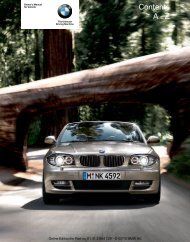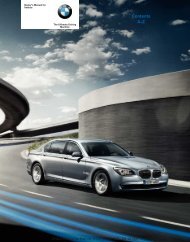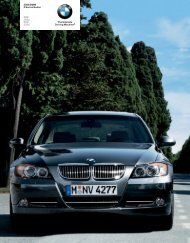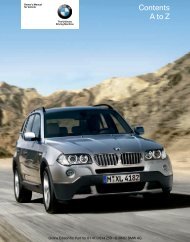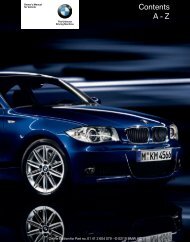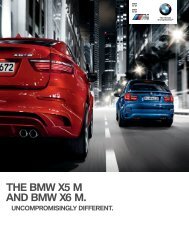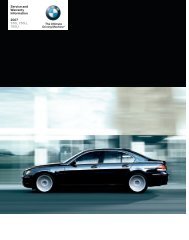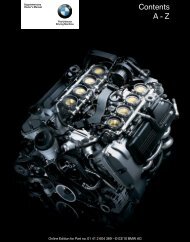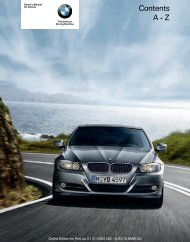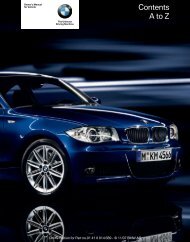2011 3 Series Owner's Manual without iDrive - Irvine BMW
2011 3 Series Owner's Manual without iDrive - Irvine BMW
2011 3 Series Owner's Manual without iDrive - Irvine BMW
You also want an ePaper? Increase the reach of your titles
YUMPU automatically turns print PDFs into web optimized ePapers that Google loves.
Temperature<br />
The temperature grades are A, the highest, B,<br />
and C, representing the tire's resistance to the<br />
generation of heat and its ability to dissipate<br />
heat when tested under controlled conditions<br />
on a specified indoor laboratory test wheel.<br />
Sustained high temperature can cause the<br />
material of the tire to degenerate and reduce<br />
tire life, and excessive temperature can lead to<br />
sudden tire failure. The grade C corresponds to<br />
a level of performance which all passenger car<br />
tires must meet under the Federal Motor Vehicle<br />
Safety Standard No. 109. Grades B and A<br />
represent higher levels of performance on the<br />
laboratory test wheel than the minimum<br />
required by law.<br />
The temperature grade for this tire is<br />
established for a tire that is properly<br />
inflated and not overloaded. Excessive speed,<br />
underinflation, or excessive loading, either separately<br />
or in combination, can cause heat<br />
buildup and possible tire failure.<<br />
RSC – run-flat tires<br />
You will recognize run-flat tires by a circular<br />
symbol containing the letters RSC on the side<br />
of the tire, refer to page 142.<br />
M+S<br />
Winter and all-season tires.<br />
These have better winter properties than summer<br />
tires.<br />
XL<br />
Designation for specially reinforced tires.<br />
Tire condition<br />
Inspect your tires frequently for tread wear,<br />
signs of damage and for foreign objects lodged<br />
in the tread. Check the tread depth.<br />
Minimum tread depth<br />
The tread depth should not drop below 0.12 in/<br />
3 mm, although, for example, European legislation<br />
only specifies a minimum tread depth of<br />
0.063 in/1.6 mm. At tread depths below<br />
0.12 in/3 mm there is an increased risk of highspeed<br />
hydroplaning, even when only small<br />
amounts of water are present on the road<br />
surface.<br />
When winter tires wear down past a tread depth<br />
of 0.16 in/4 mm, they become perceptibly less<br />
suitable for winter conditions. In the interest of<br />
safety, new tires should be installed.<br />
Wear indicators in the base of the tread groove<br />
are distributed around the tire's circumference;<br />
the letters TWI, for Tread Wear Indicator, on the<br />
tire's sidewalls identify tires that incorporate<br />
these wear indicators. Once the tire tread has<br />
worn down to the wear indicators, the tire has<br />
worn to a depth of 0.063 in/1.6 mm.<br />
Wheel/tire damage<br />
Please note that low-profile tires cause wheels,<br />
tires and suspension parts to be more susceptible<br />
to road hazard and consequential damages.<br />
Unusual vibrations encountered during normal<br />
vehicle operation can indicate tire failure or<br />
some other vehicle defect. This can, for example,<br />
be caused by driving over curbs. The same<br />
applies to any other abnormal road behavior,<br />
such as pulling severely to the right or left.<br />
In these cases, reduce speed immediately<br />
and have wheels and tires thoroughly<br />
checked. To do so, drive carefully to the<br />
nearest <strong>BMW</strong> center or tire shop that works<br />
according to <strong>BMW</strong> repair procedures with correspondingly<br />
trained personnel. If necessary,<br />
have the vehicle towed there.<br />
Otherwise, tire damage can pose a lethal hazard<br />
to vehicle occupants and other road users.<<br />
141<br />
Reference Mobility<br />
Driving tips<br />
Controls<br />
At a glance



